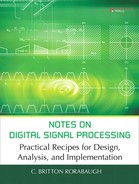Book Description
The Most Complete, Modern, and Useful Collection of DSP Recipes: More Than 50 Practical Solutions and More than 30 Summaries of Pertinent Mathematical Concepts for Working Engineers
Notes on Digital Signal Processing is a comprehensive, easy-to-use collection of step-by-step procedures for designing and implementing modern DSP solutions. Leading DSP expert and IEEE Signal Processing Magazine associate editor C. Britton Rorabaugh goes far beyond the basic procedures found in other books while providing the supporting explanations and mathematical materials needed for a deeper understanding.
Rorabaugh covers the full spectrum of challenges working engineers are likely to encounter and delves into crucial DSP nuances discussed nowhere else. Readers will find valuable, tested recipes for working with multiple sampling techniques; Fourier analysis and fast Fourier transforms; window functions; classical spectrum analysis; FIR and IIR filter design; analog prototype filters; z-transform analysis; multirate and statistical signal processing; bandpass and quadrature techniques; and much more.
Notes on Digital Signal Processing begins with mapping diagrams that illuminate the relationships between all topics covered in the book. Many recipes include examples demonstrating actual applications, and most sections rely on widely used MATLAB tools.
DSP fundamentals: ideal, natural, and instantaneous sampling; delta functions; physical signal reconstruction; and more
Fourier Analysis: Fourier series and transforms; discrete-time and discrete Fourier transforms; signal truncation; DFT leakage and resolution
Fast Fourier transforms: decimation in time and frequency; prime factor algorithms; and fast convolution
Window techniques: sinusoidal analysis; window characteristics and choices; Kaiser windows; and more
Classical spectrum analysis: unmodified and modified periodograms; Bartlett’s and Welch’s periodograms; and periodogram performance
FIR filters: design options; linear-phase FIR filters; periodicities; basic and Kaiser window methods; and the Parks-McClellan algorithm
Analog prototype filters: Laplace transforms; characterization; and Butterworth, Chebyshev, elliptic, and Bessel filters
z-Transform analysis: computation and transforms using partial fraction expansion
IIR filters: design options; impulse invariance methods; and bilinear transformation
Multirate signal processing: decimation and interpolation fundamentals; multistage and polyphase decimators and interpolation
Bandpass and quadrature techniques: bandpass sampling; wedge diagrams; complex and analytic signals; and advanced signal generation techniques
Statistical signal processing: parametric modeling of discrete-time signals; autoregressive signal models; fitting AR and All-Pole models; and more
Table of Contents
- Title Page
- Copyright Page
- Dedication Page
- Contents
- Preface
- About the Author
- Part I. DSP Fundamentals
- Part II. Fourier Analysis
- Part III. Fast Fourier Transform Techniques
- Part IV. Window Techniques
- Part V. Classical Spectrum Analysis
- Part VI. FIR Filter Design
- Note 32. Designing FIR Filters: Background and Options
- Note 33. Linear-Phase FIR Filters
- Note 34. Periodicities in Linear-Phase FIR Responses
- Note 35. Designing FIR Filters: Basic Window Method
- Note 36. Designing FIR Filters: Kaiser Window Method
- Note 37. Designing FIR Filters: Parks-McClellan Algorithm
- Part V. Analog Prototype Filters
- Part VI. z-Transform Analysis
- Note 44. The z Transform
- Note 45. Computing the Inverse z Transform Using the Partial Fraction Expansion
- Note 46. Inverse z Transform via Partial Fraction Expansion: Case 1: All Poles Distinct with M < N in System Function
- Note 47. Inverse z Transform via Partial Fraction Expansion: Case 2: All Poles Distinct with M ≥ N in System Function (Explicit Approach)
- Note 48. Inverse z Transform via Partial Fraction Expansion: Case 3: All Poles Distinct with M ≥ N in System Function (Implicit Approach)
- Part VII. IIR Filter Design
- Part VIII. Multirate Signal Processing
- Part IX. Bandpass and Quadrature Techniques
- Note 58. Sampling Bandpass Signals
- Note 59. Bandpass Sampling: Wedge Diagrams
- Note 60. Complex and Analytic Signals
- Note 61. Generating Analytic Signals with FIR Hilbert Transformers
- Note 62. Generating Analytic Signals with Frequency-Shifted FIR Lowpass Filters
- Note 63. IIR Phase-Splitting Networks for Generating Analytic Signals
- Note 64. Generating Analytic Signals with Complex Equiripple FIR Filters
- Note 65. Generating I and Q Channels Digitally: Rader’s Approach
- Note 66. Generating I and Q Channels Digitally: Generalization of Rader’s Approach
- Part X. Statistical Signal Processing
- Note 67. Parametric Modeling of Discrete-Time Signals
- Note 68. Autoregressive Signal Models
- Note 69. Fitting AR Models to Stochastic Signals: The Yule-Walker Method
- Note 70. Fitting All-Pole Models to Deterministic Signals: Autocorrelation Method
- Note 71. Fitting All-Pole Models to Deterministic Signals: Covariance Method
- Note 72. Autoregressive Processes and Linear Prediction Analysis
- Note 73. Estimating Coefficients for Autoregressive Models: Burg Algorithm
- Index
- Footnotes
